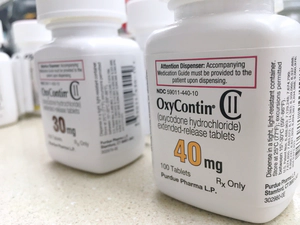Oxycodone: A Common, Addictive, and Dangerous Opioid
Oxycodone is the primary ingredient in several name-brand prescription opioid painkillers. The drug is highly addictive.

Oxycodone has been prescribed for decades, yet the use of the pain reliever is not without risk. Even when used as recommended, oxycodone is addictive, mind-altering, and has the potential to be habit-forming.
Oxycodone Defined
Oxycodone is a semi-synthetic pain reliever synthesized from the opium poppy. It is prescribed to treat both acute and chronic pain conditions. People who misuse the drug and experiment with it recreationally do so to seek the euphoric and mind-altering effects of the drug, its sedative/pain-relieving effects, or a combination of the two.1
The risk for addiction is particularly high when people use oxycodone for long periods. When used over time, oxycodone can cause physical dependence within the body, which leads to painful withdrawal symptoms and associated side effects when users stop taking the drug.
The Difference Between Oxycodone and OxyContin

Photo by PureRadiancePhoto/Shutterstock.com
Because the names are quite similar, oxycodone is often confused with OxyContin and vice versa. Both are in the category of pain-relieving medications belonging to the class of opiate or narcotic drugs. Yet despite their similarities, the drugs have several differences. OxyContin and oxycodone are two different pharmaceutical formulations of the same basic opioid medication.2
- Oxycodone is the main active ingredient in several name-brand opioid medications, including Percocet, Percodan, and OxyContin.
- OxyContin is a specific brand name for a pain medication in the opioid class. It contains the extended-release version of oxycodone and is meant to supply pain relief over a longer duration than most other oxycodone formulations.
The key difference between the two drugs is that oxycodone is the primary ingredient in several drug formulations, and OxyContin is the time-release version of oxycodone. OxyContin is simply a modified, extended-release version of oxycodone. With OxyContin and oxycodone, the same opiate substance is released into the body when the user or patient takes the drug. With OxyContin, the substance is released over a longer duration. With oxycodone, the substance is released into the body immediately.
Oxycodone Addiction Effects
People misuse oxycodone by taking it orally, intravenously, or by inhaling it. Oxycodone tablets may be crushed and sniffed or dissolved in water and injected. Some users may heat the tablet, place it on a piece of foil, and inhale the vapors produced as a result. When people experiment with oxycodone, they may experience:3
- Shock
- Nausea
- Seizures
- Vomiting
- Sweating
- Headache
- Dry mouth
- Drowsiness
- Constipation
- Itchy, irritated skin
- Lack of energy and strength
- Severely low blood pressure (hypotension)
- Decreased respiratory rate (decreased breathing)
- Difficulty swallowing (often due to extreme dry mouth)
- Adrenal insufficiency (insufficient cortisol production by the adrenal glands)
People who take oxycodone over time may experience extreme levels of drowsiness, muscle weakness, confusion, cold and clammy skin, and pinpoint pupils every time they take the drug and for some time following each use. Users who take more oxycodone than their body can handle will likely experience an overdose, which can include shallow breathing, slowed heart rate, fainting, coma, unconsciousness, and even death.
The Scope of Oxycodone Use and Prescription Drug Addiction

Sadly, oxycodone misuse has become more prolific in recent years, as has the use and abuse of other painkillers and illicit opioid drugs. According to the National Institute on Drug Abuse:4
- A little over 3% of people in the U.S. over the age of 12 (about 8.7 million people) have misused prescription opioids in the past 12 months.
- When all addictive prescription drugs are considered, at least 5% (or about 14.3 million people over the age of 12) have misused prescription drugs in the past 12 months.
- Sadly, prescription opioids are fast becoming a drug of choice among young people. Also, according to NIDA, about 1.4% of American high school students experiment with opioid pills like OxyContin and Vicodin.
- NIDA reports that about five million Americans over the age of 12 (1.8% of this age group) meet the criteria for having an addiction to prescription opioids.
- Also according to NIDA, thousands of people in the U.S. die from overdoses on prescription opioids each year.
Oxycodone is addictive, and it serves as the primary ingredient in several name-brand opioid painkillers, including OxyContin and Percocet. Though some can use it as an effective pain reliever, the risk for addiction and harmful side effects are extremely high, suggesting patients should be extremely cautious and only accept a prescription for oxycodone as a last resort (first trying other pain relief options).
Addiction Treatment Is Essential for Those Hooked on Oxycodone
When someone becomes addicted to oxycodone, they must enter treatment at a qualified residential drug rehab center as soon as possible. Any opioid addiction can easily lead to a fatal overdose, and oxycodone addiction is no exception. According to the Centers for Disease Control and Prevention, the annual death rate from opioid overdoses in 2021 was six times the number in 1999.[5] About 15,000 to 17,000 people lose their lives in the U.S. each year to overdoses on prescription opioid painkillers.5
If you know someone who experiments with oxycodone or other opioids and cannot stop doing so on their own, please help them find and enter a residential treatment center as soon as possible. Please do not wait until it is too late. Even if your loved one has a legitimate prescription for oxycodone, an addiction to the drug is an emergency-level condition and must be addressed immediately.
Sources:
-
DEA. “Oxycodone.” Drug Enforcement Administration, 2020. dea.gov ↩︎
-
VWH. “What’s the Difference Between Oxycodone and OxyContin?” VeryWellHealth, 2023. verywellhealth.com ↩︎
-
DEA. “Oxycodone.” Drug Enforcement Administration, 2024. dea.gov ↩︎
-
CDC. “What Is the Scope of Prescription Drug Misuse in the United States?” National Institute on Drug Abuse, 2020. nida.nih.gov ↩︎
-
NIDA. “Drug Overdose Death Rates.” National Institute on Drug Abuse, 2023. nida.nih.gov ↩︎







 ®
®